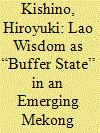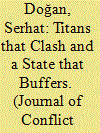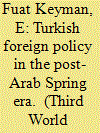|
|
|
Sort Order |
|
|
|
Items / Page
|
|
|
|
|
|
|
| Srl | Item |
| 1 |
ID:
157675


|
|
|
|
|
| Summary/Abstract |
Lao PDR, located in a geopolitically strategic area of the Mekong region, has served as a “buffer state” without being placed under any one country's influence, contributing to the status quo of regional power balance. The skillful balanced diplomacy of Lao PDR has enabled it to keep this position. Yet, in face of growing Chinese presence, how long will that be the case? With an emerging regional economy across borders in the Mekong region as the background, Lao PDR, a small, land-locked country, has achieved relatively high economic growth rates and has started to attract foreign direct investment in recent years. In this process, Japanese companies have started to invest in manufacturing there, and Japan-Laos business partnership has been taking off. Looking for further development, Lao PDR has been consolidating its position as the “battery of the Mekong,” a net exporter of electricity. By improving its connectivity with neighboring countries, Lao PDR has also been making untiring efforts to become a “land-linked” country, aiming to serve as a “logistic hub” for the region, taking advantage of its geopolitical advantage, Yet, many challenges exist before this goal is achieved.
|
|
|
|
|
|
|
|
|
|
|
|
|
|
|
|
| 2 |
ID:
164247


|
|
|
|
|
| Summary/Abstract |
This article looks at Nepal’s Buffer State predicament and the path that India and Nepal must follow to meet the national interests of both countries. The rise of Nepalese nationalism with a communist complexion and the rise of China, which seeks to expand its sphere of influence, have led to Nepal being pushed into what can be called as the “New Small Game”.China’s growing profile in the Himalayan country is a threat to India’s security interests and India has to be proactive to maintain the buffer status of Nepal. The Nepalese economic situation and sovereignty issues have motivated Nepal to seek help from China for meeting its infrastructural and transportation needs. However, the geographical advantage that India provides to Nepal for land transportation access can still not be matched by China which will affect Nepal’s strategic calculations. The demand for modification to the Indo-Nepal Treaty of 1950 is fallout of assertion of sovereignty and an unreal threat of being swamped by Indian immigrants. So far, the Nepalese have demonstrated remarkable understanding and good diplomatic skills to balance between two antagonistic neighbours. However, the planned Chinese land road/rail connectivity across the Himalayas increases India’s insecurity as it dilutes the buffer status. India cannot stop Nepal from seeking Chinese assistance. On its part Nepal has to balance its needs with the advantages of a neutral buffer. Perhaps with strict neutrality Nepal can become for the subcontinent what Switzerland was for Europe. India must help Nepal to achieve this and remain an effective buffer.
|
|
|
|
|
|
|
|
|
|
|
|
|
|
|
|
| 3 |
ID:
189006


|
|
|
|
|
| Summary/Abstract |
We present a game-theoretic approach to the analysis of the emergence or survival of buffer states. We analyze a two-stage game with three players orderly located on a linear territory, where the player in the middle is passive, and the players on the two ends are aggressive with options to declare war against the others. We conduct an equilibrium analysis and characterize the conditions under which the passive player acts as a buffer state between the aggressive players. We find various equilibrium outcomes, which can be grouped into the following categories: (i) peace with buffer, (ii) peace without buffer, and (iii) the last man standing. Our comparative static analyses reveal valuable insights regarding the factors affecting the existence of buffer states.
|
|
|
|
|
|
|
|
|
|
|
|
|
|
|
|
| 4 |
ID:
149444


|
|
|
|
|
| Summary/Abstract |
Our globalising world is presently in a state of global turmoil. Risk, uncertainty, and insecurity are the terms that shape global/regional/national/local affairs and developments. The refugee crisis and the war against ISIL constitute the twin crises creating seismic impacts and consequences that in turn escalate risk and turmoil. Turkey is situated at the heart of these two crises, being very much affected by them and, therefore, perceived as a pivotal actor in the way in which the West is dealing with them. Yet, the West’s current instrumentalist and functionalist approach to Turkey as a buffer state designed to contain these two crises in the MENA does not offer an effective and sustainable solution to these crises, much less provide the stability and order that is direly needed in regional and global affairs.
|
|
|
|
|
|
|
|
|
|
|
|
|
|
|
|
|
|
|
|
|